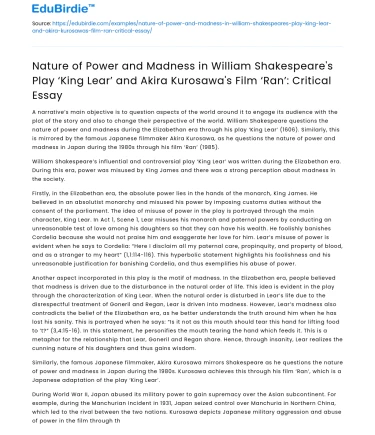A narrative’s main objective is to question aspects of the world around it to engage its audience with the plot of the story and also to change their perspective of the world. William Shakespeare questions the nature of power and madness during the Elizabethan era through his play ‘King Lear’ (1606). Similarly, this is mirrored by the famous Japanese filmmaker Akira Kurosawa, as he questions the nature of power and madness in Japan during the 1980s through his film ‘Ran’ (1985).
William Shakespeare’s influential and controversial play ‘King Lear’ was written during the Elizabethan era. During this era, power was misused by King James and there was a strong perception about madness in the society.
Save your time!
We can take care of your essay
- Proper editing and formatting
- Free revision, title page, and bibliography
- Flexible prices and money-back guarantee
Firstly, in the Elizabethan era, the absolute power lies in the hands of the monarch, King James. He believed in an absolutist monarchy and misused his power by imposing customs duties without the consent of the parliament. The idea of misuse of power in the play is portrayed through the main character, King Lear. In Act 1, Scene 1, Lear misuses his monarch and paternal powers by conducting an unreasonable test of love among his daughters so that they can have his wealth. He foolishly banishes Cordelia because she would not praise him and exaggerate her love for him. Lear’s misuse of power is evident when he says to Cordelia: “Here I disclaim all my paternal care, propinquity, and property of blood, and as a stranger to my heart” (1,1:114-116). This hyperbolic statement highlights his foolishness and his unreasonable justification for banishing Cordelia, and thus exemplifies his abuse of power.
Another aspect incorporated in this play is the motif of madness. In the Elizabethan era, people believed that madness is driven due to the disturbance in the natural order of life. This idea is evident in the play through the characterization of King Lear. When the natural order is disturbed in Lear’s life due to the disrespectful treatment of Goneril and Regan, Lear is driven into madness. However, Lear’s madness also contradicts the belief of the Elizabethan era, as he better understands the truth around him when he has lost his sanity. This is portrayed when he says: “Is it not as this mouth should tear this hand for lifting food to ’t?” (3,4:15-16). In this statement, he personifies the mouth tearing the hand which feeds it. This is a metaphor for the relationship that Lear, Goneril and Regan share. Hence, through insanity, Lear realizes the cunning nature of his daughters and thus gains wisdom.
Similarly, the famous Japanese filmmaker, Akira Kurosawa mirrors Shakespeare as he questions the nature of power and madness in Japan during the 1980s. Kurosawa achieves this through his film ‘Ran’, which is a Japanese adaptation of the play ‘King Lear’.
During World War II, Japan abused its military power to gain supremacy over the Asian subcontinent. For example, during the Manchurian Incident in 1931, Japan seized control over Manchuria in Northern China, which led to the rival between the two nations. Kurosawa depicts Japanese military aggression and abuse of power in the film through the violent attack of Taro and Jiro on their father, Hidetora, to gain complete control of the state. This scene from the film draws parallels between Japan’s and the brothers’ greed for power. Kurosawa utilizes color symbolism and uses bold primary colors such as red and yellow to differentiate between Taro’s and Jiro’s soldiers. These warm colors evoke danger and the alarming yearning the brothers have for power. During this scene, the audience are able to see Hidetora’s sword breaking when he fights with Taro’s soldiers. This is symbolic of the transition of Hidetora from a warrior to a victim, and also signifies his loss of power. Therefore, Kurosawa questions and reflects upon the Japanese militarism through this particular scene in his film ‘Ran’.
Madness during the 1980s in Japan stemmed from the fear of atomic danger. Japanese people and the government were terrified of the upcoming nuclear apocalypse. Kurosawa incorporates this fear into his main character, Hidetora, in the form of madness. Like the Japanese, Hidetora loses his sanity due to his sons’ attack on him, as well as his violent past. During the attack of Hidetora’s sons, there is foreshadowing of Hidetora’s madness through the shots of the sky changing from clear to grey. The sky changing to grey symbolizes Hidetora’s changing mental state, and also the dark event of the sons attacking their father. Kurosawa also plays soft dramatic music throughout the scenes of the attack to contrast between the visuals and the audio. This mismatch of the visual and the audio is a symbol for Hidetora’s mental state and exemplifies his inner confusion. Thus, Kurosawa draws links between Hidetora’s madness and Japan’s madness, as both of them had a violent past which makes them lose their sanity.
Conclusively, both Shakespeare’s ‘King Lear’ and Kurosawa’s ‘Ran’ question aspects of their world by incorporating them into their narrative’s plot and characters in order to engage their audiences. Shakespeare questions the nature of power and madness during the Elizabethan era through his main character, Lear, mirrored by Kurosawa who questions the nature of power and madness in Japan during the 1980s also through his main character, Hidetora.






 Stuck on your essay?
Stuck on your essay?

